- Details
- Written by: author
"What on earth is that?" I whisper to Marion. There's no way she hasn't heard the blood curdling snarls outside our tent. "It must be stray dogs" she muffles back. I feel too exposed behind only thin fabric, listening silently. I reach for my head torch and then in one movement I open the zip and jump outside the tent. The light illuminates four pairs of eyes fifty metres away. Unflinchingly they return a stare, neither retreating nor advancing. "What is it?" Marion asks, "Just some dogs, fighting over rubbish" I reply. I dare not move the torch beam off them while I collect some tennis ball-size rocks and stack them like a kid preparing for a snowball fight. I lob just one at them and they casually turn and slink into the bushes. Only then do I see their size and shape - these aren't stray dogs, they're four identical large wolves. I'm not getting much sleep tonight it seems.
We knew riding our bikes across the remote western edge of Sichuan in China was going to be an interesting experience. This is the province associated with giant pandas, misty mountains and the delicious but fiery Sichuan cuisine, but we wouldn't see much of this. While it's called Sichuan, where we were going is technically not China at all. In 1950 the red army marched the same route when they fought in the battle of Chamdo and defeated the Tibetan army, which triggered events that led to the end of Tibet's independence. This area is known as Kham and was a part of Tibet. It might be 66 years since the end of independence, but on the main highway at least 150 military trucks overtake us each day: it seems the Chinese never stopped marching into Tibet.
Up from the off
After two days of air travel, getting the bikes safely out of boxes is a relief. We have flown via Beijing into Chengdu, then taken a ten-hour bus journey through the lush green Sichuan mountains to Kangding. The sun is shining on the snowy peaks and the autumnal temperatures are perfect. We're both nervous and excited in equal measure because the itinerary is a totally blank map - with little information available we're simply riding one road at a time to see what happens.
Our first destination is the Tibetan plateau town of Litang, 300km away and at 4100m altitude. However, before leaving Kangding we stop to fill our stove bottle with petrol. "No: police" is the response from each petrol station we visit. We discover the frequent self-immolation (a protest at Chinese rule where monks set themselves on fire) has led to tight restrictions on selling petrol here. Finally we find a mechanic willing to drain a car's tank for us, and our desperation turns to gratitude!
We soon leave the concrete of Kangding and we're on the main road to Lhasa, with its smooth new ribbon of tarmac that's perfect for cycling. The landscape is rolling high-altitude pasture dotted with nomads' tents and the horizon is pierced by a few glaciated summits. In the valleys are traditional Tibetan villages where friendly locals sell us spicy dried yak meat. This might sound unappetising but it's a perfect riding snack.
Right from the off the going is tough, with a steady climb up to 3800m and it's only day one. With no acclimatisation it's a struggle - we're in silence and both feel jet-lagged, only made worse by the lack of oxygen. The gradient is steady at least and taking it pedal by pedal we finally approach the pass. Chinese tourists who stop to admire the view are soon in our faces taking selfies, pushing, shoving and bemused by these two cyclists who for some reason rode their bikes up here. We're not in the mood to pose for pictures. We just want to recover and soak up the views framed by endless prayer flags, each one like a child's kite flapping in the wind.
The descent into the shadowy evening air is fast but so cold - even with full layers on we chill to the bone. It's time to get the stove burning and to wild camp on the high-altitude grassland.
Over the next few days a theme develops: climbing up to passes with captivating prayer flags, long descents and at some point the day's military convoy will pass. If we stop in laybys we're quickly offered Tibetan butter tea from huge hot flasks. This cheesy, salty tea is an acquired taste but appeals to the dry mouth of a cyclist. You won't see it offered in Costa anytime soon though, that's for sure!
After a six kilometre tunnel of death with no ventilation at 4200m, we see the light and roll into Litang. Construction is booming here as part of the Chinese resettlement programme. New hotels, apartments and government buildings are changing the town's character fast. Beyond the dust is the traditional Tibetan sector, nestled below a sprawling Buddhist monastery and temple complex.
The sun is setting with a beautiful diffuse golden light, and we get our first glimpse of sky burial sites on the grassy hills above town. Flags flutter where the funerals of Tibetans leave the deceased for the vultures - it's brutal in some ways but perfectly completes a circle of life, something Western culture has certainly lost. One thing's for sure: there's a healthy population of vultures in Tibet, with the bearded vulture the biggest with its nine-foot wingspan.
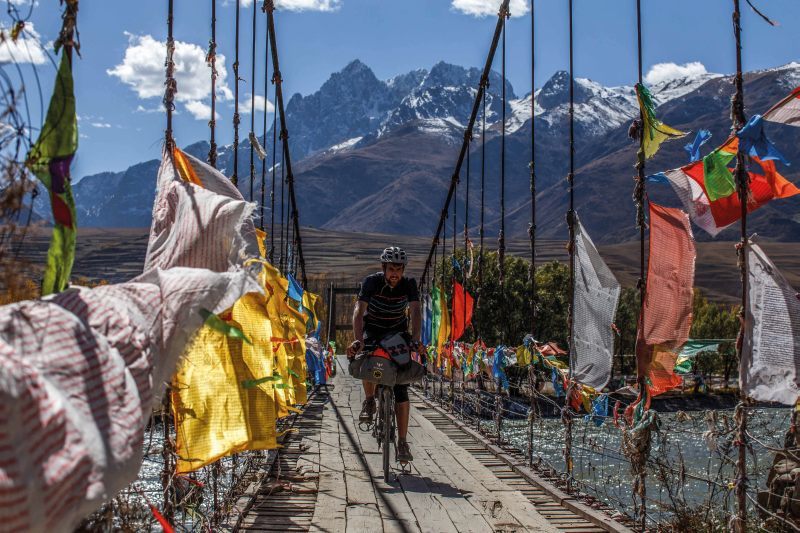
The monastery in Litang is a beautiful place with huge temples in bright reds and yellows, all gleaming with golden roofs, but it's not at its best due to some substantial building work. Most monasteries across this region are being renovated or are brand new it seems and the sheer scale of these projects raises the question of how they're being funded.
Bike diplomacy
It turns out that Buddhist monks love bikes, especially my titanium Tripster. In most monasteries we visit we're given an 'exclusive' tour in return for a spin. Once again bikes prove such a great instrument for sparking unexpected but rewarding interactions. They also build up a huge appetite for local food!
For dinner we sample the traditional yak dumplings and they're ideal cyclist food: deep-fried and super tasty. We have more butter tea to wash them down; this time actual cheese is added! So far the food has been a mix of spicy Sichuan noodle soups and Tibetan style bread, cheese, dumplings and yak meat - all outstandingly tasty. Hotpot is big here too; an incredibly spicy broth that you dip literally anything in to cook then eat. It's a social meal and we've been kindly invited to join locals a few times. Mostly for them to laugh at how we deal with the spice and our polite chopstick eating!
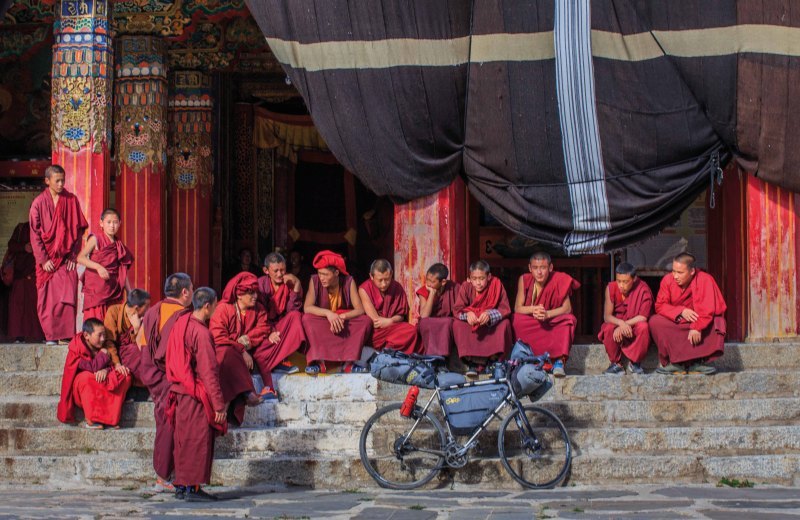
From Litang we head north on quieter roads, where the villages are untouched by Chinese influence. The traditional wooden buildings all share identical designs: the ground floor is for animals, the first floor for living then the top is normally a hay loft. They're surprisingly grand in scale with bold decoration. The living floor has an 'en-suite' toilet, which consists of a wooden box latched onto the outside - they're just long drops so we're careful what we walk under!
One night we detour to a particularly beautiful old monastery perched on a sparsely forested mountain. The track up is sandy and steep, reducing us to pushing. Once inside we're met by blank stares; it feels like we're the first westerners these young monks have ever seen. After a few minutes it's clear we won't camp here. We set up the tent further down the track on a flat corner. This is the night we get visited by wolves. By morning we're tired but alive - they came back three more times during the small hours. We've seen a lot of stray dogs but we didn't expect wolves.
After the Tibetan town of Garze we reach the big challenge of the trip; Tro La pass (5050m). Thankfully we are now ten days in and find sleeping at over 4000m is no longer restless and breathless - we're acclimatised and ready.
Part way up the climb is an azure glacial lake. We stop to camp on its shores for a spectacular night under the stars. In the high alpine the silver glaciers reflect the moonlight back - it's a cliché but why would you want to sleep in some fancy hotel when there's experiences like this for free!
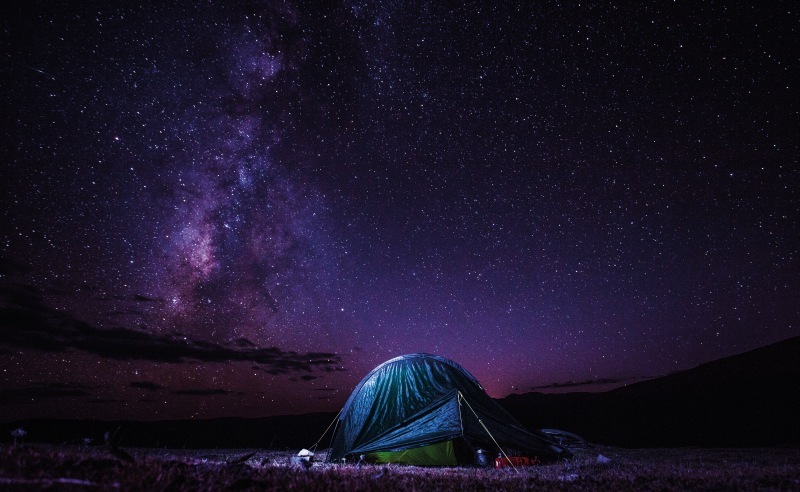
In the morning the climbing starts again, we ride over 25km before hitting the final steep hairpins. At this point it turns to gravel and the dust from huge tankers passing us make it even more of a challenge.
The long slog generates a jaw dropping view but more importantly leads us to the arch of prayer flags indicating the top. Empty cans of oxygen discarded by Chinese drivers only highlight our achievement.
What goes up must come down and so that's what we do - for 60kms. First we descend on steep gravel switchbacks then through pastures before dropping into a steep-sided gorge to the town of Derge. Here we reach a larger river defining the border with Chamdo and the Tibetan Autonomous Region. This border is closed to all foreigners, and police guard the bridge, modern CCTV cameras no doubt tracking our every move.
Derge is home to a temple which houses one of the largest collection of wooden carved Tibetan Buddhist scriptures: a deeply religious site and a fascinating place to wander. We don't stay long though, as the first snowflakes of the trip start falling. As we ride alongside the river - across the closed border, every single house is by law flying a Chinese flag, and it's an eerie spectacle.
Monastic masses
We're heading to a place hidden high up in these desolate mountains called Yarchen Gar. It's not on maps and few westerners have ventured there; it's the world's largest Buddhist monastery with 10,000 nuns and monks. A similar scale settlement to the north east was recently closed to implement a 'fire safety' demolition policy. The future of Yarchen Gar is uncertain so we're keen to visit now.
As we push the final climb we look over a vast monastic shanty town dwarfed by four vast temples. With thousands of burgundy-robed figures on the move below us it's one of the most surreal sights we've experienced.
Two young monks wander over to us, interested in the bikes. The older one can hop on Marion's bike but the younger one is too small to reach the pedals. He sits on my saddle and I push him about, then Marion shouts "give him a backie!". He happily sits on my Apidura saddle pack while I stand up pedaling, both of us whooping as we go. It's great to see their beaming smiles even if I nearly collapse from the effort at this altitude!
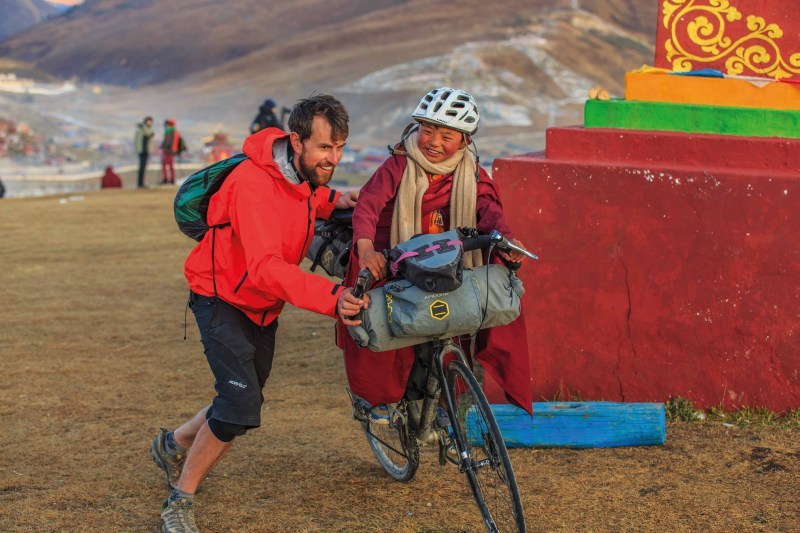
That night we're invited to sleep in a monk's prayer room - with him taking pity on us camping out in the freezing temperatures. It is an honour to be invited and an amazing opportunity to experience everyday life here.
The rest of the trip flies past. We ride a beautiful route back to Kangding via Tagong. Along the way I end up naked in a hot spring with a famous Lama (Buddhist monk not the animal), we gate crash a locals' only Tibetan festival, try to acquire a pack horse and finally on the last day of riding I become very sick with a final pass to climb. All I can remember is Marion flagging a lift then me trying not to vomit while staggering into a hotel.
It's a sour way to end an incredible adventure but but the constant challenge of simply communicating basic needs and the unexpected rigours of the mountainous riding have all but destroyed me. Was it worth the effort? I don't think I even need to answer this question. To me, living life is all about riding your bike to discover unforgettable experiences like this.
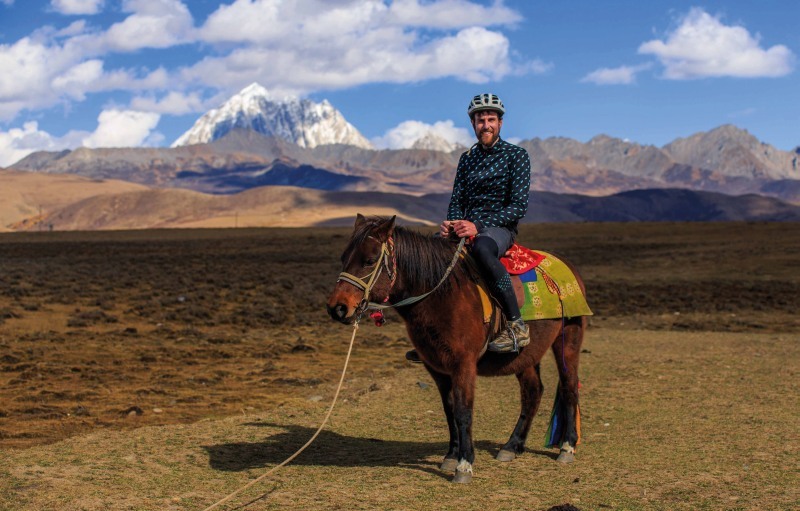
Our trip
We travelled entirely independently. It was very challenging at times with no more than a handful of English speakers encountered. However the beauty of Western Sichuan is that it's one of the only parts of old Tibet still open for independent travel. Organised tours tend to focus on the Tibetan Autonomous Region where all foreigners require a guide by law and prices rise accordingly.
The Land of the Snows is an amazing resource for all areas of Tibet thelandofsnows.com




